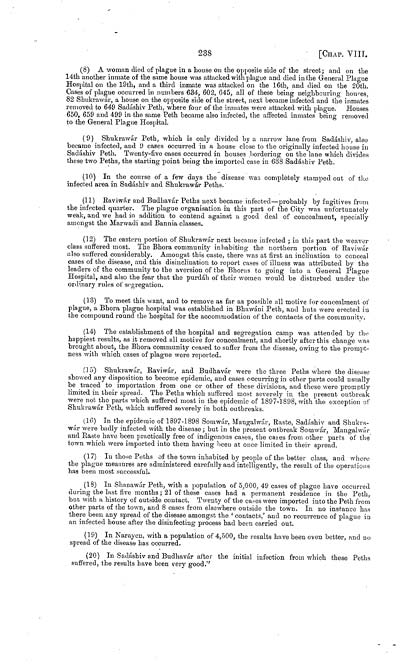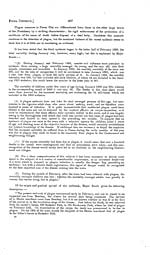Medicine - Disease > Bombay plague: being a history of the progress of plague in the Bombay presidency from September 1896 to June 1899
(307) Page 238
Download files
Individual page:
Thumbnail gallery: Grid view | List view

238 [CHAP. VIII.
(8) A woman died of plague in a house on the opposite side of the street; and on the
14th another inmate of the same house was attacked with plague and died in the General Plague
Hospital on the 19th, and a third inmate was attacked on the 16th, and died on the 20th.
Cases of plague occurred in numbers 634, 602, 645, all of these being neighbouring houses,
82 Shukrawr, a house on the opposite side of the street, next became infected and the inmates
removed to 649 Sadshiv Peth, where four of the inmates were attacked with plague. Houses
650, 659 and 499 in the same Peth became also infected, the affected inmates being removed
to the General Plague Hospital.
(9) Shukrawr Peth, which is only divided by a narrow lane from Sadshiv, also
became infected, and 9 cases occurred in a house close to the originally infected house in
Sadshiv Peth. Twenty-five cases occurred in houses bordering on the lane which divides
these two Peths, the starting point being the imported case in 688 Sadshiv Peth.
(10) In the course of a few days the disease was completely stamped out of the
infected area in Sadshiv and Shukrawr Peths.
(11) Raviwr and Budhavr Peths next became infected-probably by fugitives from
the infected quarter. The plague organisation in this part of the City was unfortunately
weak, and we had in addition to contend against a good deal of concealment, specially
amongst the Marwadi and Bannia classes.
(12) The eastern portion of Shukrawr next became infected ; in this part the weaver
class suffered most. The Bhora community inhabiting the northern portion of Raviwr
also suffered considerably. Amongst this caste, there was at first an inclination to conceal
cases of the disease, and this disinclination to report cases of illness was attributed by the
leaders of the community to the aversion of the Bhoras to going into a General Plague
Hospital, and also the fear that the purdah of their women would be disturbed under the
ordinary rules of segregation.
(13) To meet this want, and to remove as far as possible all motive for concealment of
plague, a Bhora plague hospital was established in Bhawni Peth, and huts were erected in
the compound round the hospital for the accommodation of the contacts of the community.
(14) The establishment of the hospital and segregation camp was attended by the
happiest results, as it removed all motive for concealment, and shortly after this change was
brought about, the Bhora community ceased to suffer from the disease, owing to the prompt-
ness with which cases of plague were reported.
? 5) Shukrawr, Raviwr, and Budhavr were the three Peths where the disease
showed any disposition to become epidemic, and cases occurring in other parts could usually
be traced to importation from one or other of these divisions, and these were promptly
limited in their spread. The Peths which suffered most severely in the present outbreak
were not the parts which suffered most in the epidemic of 1897-1898, with the exception of
Shukrawr Peth, which suffered severely in both outbreaks.
(16) In the epidemic of 1897-1898 Somwr, Mangalwr, Raste, Sadshiv and Shukra-
wr were badly infected with the disease ; but in the present outbreak Somwr, Mangalwr
and Raste have been practically free of indigenous cases, the cages from other parts of the
town which were imported into them having been at once limited in their spread.
(17) In those Peths of the town inhabited by people of the better class, and where
the plague measures are administered carefully and intelligently, the result of the operations
has been most successful.
(18) In Shanawr Peth, with a population of 5,000, 49 cases of plague have occurred
during the last five months ; 21 of these cases had a permanent residence in the Peth,
but with a history of outside contact. Twenty of the cases were imported into the Peth from
other parts of the town, and 8 cases from elsewhere outside the town. In no instance has
there been any spread of the disease amongst the ' contacts,' and no recurrence of plague in
an infected house after the disinfecting process had been carried out.
(19) In Narayeu, with a population of 4,500, the results have been even better, and no
spread of the disease has occurred.
(20) In Sadshiv and Budhavr after the initial infection from which these Peths
suffered, the results have been very good."
(8) A woman died of plague in a house on the opposite side of the street; and on the
14th another inmate of the same house was attacked with plague and died in the General Plague
Hospital on the 19th, and a third inmate was attacked on the 16th, and died on the 20th.
Cases of plague occurred in numbers 634, 602, 645, all of these being neighbouring houses,
82 Shukrawr, a house on the opposite side of the street, next became infected and the inmates
removed to 649 Sadshiv Peth, where four of the inmates were attacked with plague. Houses
650, 659 and 499 in the same Peth became also infected, the affected inmates being removed
to the General Plague Hospital.
(9) Shukrawr Peth, which is only divided by a narrow lane from Sadshiv, also
became infected, and 9 cases occurred in a house close to the originally infected house in
Sadshiv Peth. Twenty-five cases occurred in houses bordering on the lane which divides
these two Peths, the starting point being the imported case in 688 Sadshiv Peth.
(10) In the course of a few days the disease was completely stamped out of the
infected area in Sadshiv and Shukrawr Peths.
(11) Raviwr and Budhavr Peths next became infected-probably by fugitives from
the infected quarter. The plague organisation in this part of the City was unfortunately
weak, and we had in addition to contend against a good deal of concealment, specially
amongst the Marwadi and Bannia classes.
(12) The eastern portion of Shukrawr next became infected ; in this part the weaver
class suffered most. The Bhora community inhabiting the northern portion of Raviwr
also suffered considerably. Amongst this caste, there was at first an inclination to conceal
cases of the disease, and this disinclination to report cases of illness was attributed by the
leaders of the community to the aversion of the Bhoras to going into a General Plague
Hospital, and also the fear that the purdah of their women would be disturbed under the
ordinary rules of segregation.
(13) To meet this want, and to remove as far as possible all motive for concealment of
plague, a Bhora plague hospital was established in Bhawni Peth, and huts were erected in
the compound round the hospital for the accommodation of the contacts of the community.
(14) The establishment of the hospital and segregation camp was attended by the
happiest results, as it removed all motive for concealment, and shortly after this change was
brought about, the Bhora community ceased to suffer from the disease, owing to the prompt-
ness with which cases of plague were reported.
? 5) Shukrawr, Raviwr, and Budhavr were the three Peths where the disease
showed any disposition to become epidemic, and cases occurring in other parts could usually
be traced to importation from one or other of these divisions, and these were promptly
limited in their spread. The Peths which suffered most severely in the present outbreak
were not the parts which suffered most in the epidemic of 1897-1898, with the exception of
Shukrawr Peth, which suffered severely in both outbreaks.
(16) In the epidemic of 1897-1898 Somwr, Mangalwr, Raste, Sadshiv and Shukra-
wr were badly infected with the disease ; but in the present outbreak Somwr, Mangalwr
and Raste have been practically free of indigenous cases, the cages from other parts of the
town which were imported into them having been at once limited in their spread.
(17) In those Peths of the town inhabited by people of the better class, and where
the plague measures are administered carefully and intelligently, the result of the operations
has been most successful.
(18) In Shanawr Peth, with a population of 5,000, 49 cases of plague have occurred
during the last five months ; 21 of these cases had a permanent residence in the Peth,
but with a history of outside contact. Twenty of the cases were imported into the Peth from
other parts of the town, and 8 cases from elsewhere outside the town. In no instance has
there been any spread of the disease amongst the ' contacts,' and no recurrence of plague in
an infected house after the disinfecting process had been carried out.
(19) In Narayeu, with a population of 4,500, the results have been even better, and no
spread of the disease has occurred.
(20) In Sadshiv and Budhavr after the initial infection from which these Peths
suffered, the results have been very good."
Set display mode to: Large image | Zoom image | Transcription
Images and transcriptions on this page, including medium image downloads, may be used under the Creative Commons Attribution 4.0 International Licence unless otherwise stated. ![]()
| India Papers > Medicine - Disease > Bombay plague: being a history of the progress of plague in the Bombay presidency from September 1896 to June 1899 > (307) Page 238 |
|---|
| Permanent URL | https://digital.nls.uk/74586582 |
|---|




